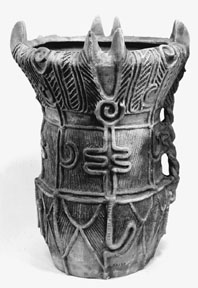

 | Page 739 |  |
statement about prehistoric and proto-historic settlement systems, inferring social transformations that would have led to an early state with class differentiation (Wajima 1948). Similarly, Yukio Kobayashi (1911–1988) attributed class differentiation and state formation during the Kofun period (a.d. 300–600) to a rise in agricultural productivity that resulted from the widespread use of iron tools (Y. Kobayashi 1952). Such attempts at generalizations, however, were exceptional. For the majority of archaeologists, the particularist approach, with its emphasis on stratigraphic and typological evidence, which had been strongly entrenched in the 1930s, continued—and, in fact, continues to this day.
It was during this early postwar environment of freedom of speech, at a symposium in 1948, that Namio Egami first presented his thesis that the Japanese imperial family’s ancestors had arrived relatively late in Japan and were the riders of horses from the continent (Egami 1962, 1964). Although this idea continues to be very popular with the reading public in Japan, and gained support of some foreign scholars (e.g., Hong 1988; Ledyard 1975), most Japanese archaeologists have dismissed it as being speculative and not worthy of serious rebuttal. It was only recently that one scholar decided to remedy the situation by presenting a counterargument (Sahara 1993).

A pottery jar from the Nagano–Ken jomon culture (3000–2000 B.C.), probably used for storing food
The Art Archive
Many Japanese archaeologists had studied abroad before World War II, and even during the early phase of the war, and a number of them had been engaged in archaeological investigations in the newly occupied areas of Manchuria, china, Indochina, and the Pacific islands. As the war progressed they became increasingly isolated, and this isolation continued in the early postwar decades when foreign travel and the importation of foreign books were severely limited by economic conditions. Isolation ended gradually when a small number of young archaeologists were given the opportunity to study abroad and a few senior scholars were able to attend international meetings. International interaction has increased rapidly since the 1970s, and Japanese archaeologists are once again engaged in overseas expeditions in places such as peru, Alaska, and the Middle East.
Newly developed archaeological methods and techniques were introduced. Soon after radiocarbon dating was developed, it was applied to samples from several Jomon sites, with occupation forces personnel and visiting U.S. archaeologists acting as intermediaries (Crane 1956; Crane and Griffin 1962; Libby 1951). These and subsequent determinations produced internally consistent, and surprisingly early dates, suggesting that Japanese pottery making was the earliest in the world.
A curious debate over the legitimacy of using radiocarbon dates in archaeological interpretation began. As noted elsewhere (Ikawa-Smith 1975,15–17), the debate had little to do with the reliability of the method itself but instead concerned the integrity of archaeology as a historical discipline whose expertise resided in its ability to construct a chronology based on the
 |  |